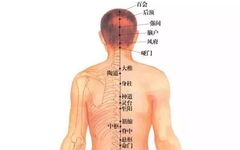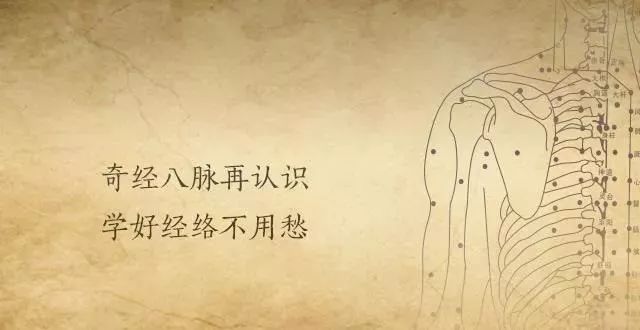
Editor’s Note
|
Traditional Chinese Medicine (TCM) posits that besides the Zang-Xiang (organ manifestations), another crucial aspect is the meridian system. This system connects the Zang-Fu organs and the body surface, linking the various organs and tissues into an organic whole, facilitating the flow of Qi and blood, and maintaining the functional activities of the body in a coordinated and relatively balanced manner.
The meridian system consists of the Jingmai (meridians) and Luomai (collaterals). The Jingmai includes the twelve primary meridians and the Eight Extraordinary Meridians, along with the Jingbie (branch meridians), Jingjin (muscle meridians), and Pibu (skin meridians). The Eight Extraordinary Meridians refer to the Du Mai (Governing Vessel), Ren Mai (Conception Vessel), Chong Mai (Penetrating Vessel), Dai Mai (Belt Vessel), Yin Wei Mai (Yin Linking Vessel), and Yang Wei Mai (Yang Linking Vessel). While the twelve primary meridians are directly associated with the Zang-Fu organs, the Eight Extraordinary Meridians are neither directly linked to the Zang-Fu nor do they have a corresponding exterior-interior relationship. So why study them? What clinical significance do they hold? |
The Eight Extraordinary Meridians are an essential component of the meridian system, with extensive connections to the twelve primary meridians, branch meridians, muscle meridians, collaterals, and skin meridians. They play a significant role in the circulation of Qi and blood throughout the body. The Nan Jing (Classic of Difficulties) compares the Eight Extraordinary Meridians to a “deep lake,” while the twelve primary meridians are likened to “canals,” summarizing the relationship of Qi and blood regulation in the body as “when the canals overflow, they flow into the deep lake… when the human pulse is prosperous, it enters the Eight Meridians without circulating around.”
Throughout history, various physicians such as Wang Shuhe, Zhang Zhongjing, and Ye Tianshi have conducted varying degrees of research on the Eight Extraordinary Meridians. In the Ming Dynasty, Li Shizhen systematically organized, developed, and refined the system of the Eight Extraordinary Meridians. Since the 1970s, many scholars have conducted in-depth studies on the theories of the Eight Extraordinary Meridians, achieving significant results that enrich and enhance the content of these meridians.
1. Understanding the Du Mai
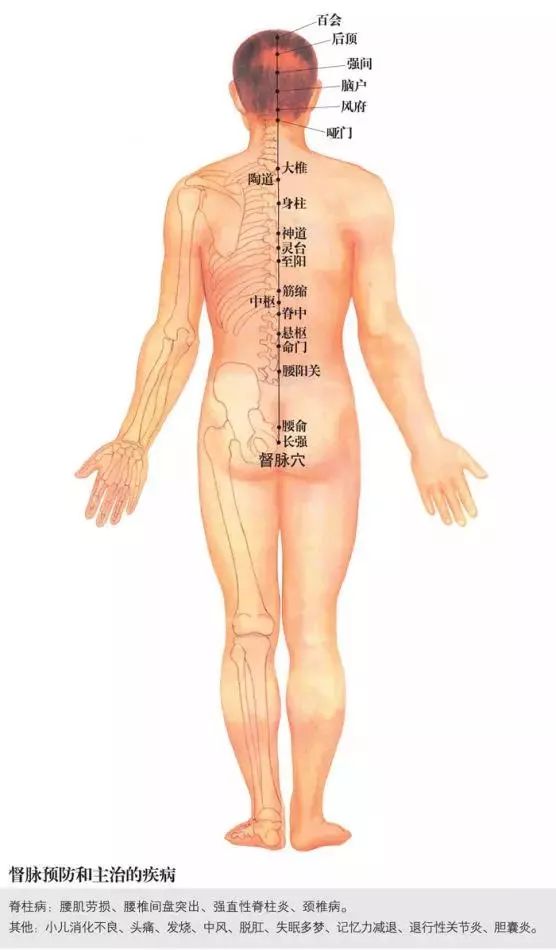
Descriptions of the pathway of the Du Mai by physicians throughout history generally rely on the records in the Nan Jing. Prior to the 1980s, various texts followed the main line of the Du Mai running along the center of the back. The 1984 national standardized TCM textbook “Meridian Studies” supplemented the three branches entering the Du Mai based on the records in the Nei Jing (Inner Canon). The 1995 textbook for higher education in TCM, “Meridian Studies,” primarily referenced the records in the Ling Shu (Spiritual Pivot) regarding the Du Mai, supplemented by discussions in the Su Wen (Plain Questions) and Nan Jing, restoring the ancient descriptions of the Du Mai. According to the flow of the twelve meridians, which is based on the operation of Ying Qi (Nutritional Qi), it was proposed that the direction of the Du Mai should also follow this standard, flowing from top to bottom, which is the normal direction of Ying Qi flow.
Since the Nan Jing, the direction of the Du Mai has been considered to flow from bottom to top, a viewpoint that has been maintained for over two thousand years. Teacher Li Ding believes that the special reverse direction mentioned in the Nan Jing is primarily related to the phenomenon of internal Qi flow in Qigong practitioners. Huang Lun explains the direction of the Du Mai based on the process of human birth, asserting that the object referred to in the Ling Shu regarding Ying Qi is an adult individual (i.e., a being separated from the mother), which has already become a unified entity with nature. The Ying Qi, derived from the essence of food and water, flows along the meridians in the body. Before birth, the Ying Qi is received from the mother through the umbilical cord and kidneys, with the Dantian (elixir field) being Yin. Therefore, the Du Mai flows from bottom to top. After birth, the Du Mai transitions from Yin to Yang, aligning with the records in the Ling Shu regarding Ying Qi.
Its functions have been summarized as governing all meridians, regulating meridian Qi; maintaining Yang Qi, defending against external pathogens; distributing the fire of the Mingmen (Gate of Life), warming the Zang-Fu organs; transporting Yin essence, nourishing the brain and marrow; participating in the transformation and movement of Ying Qi.
2. Understanding the Chong Mai
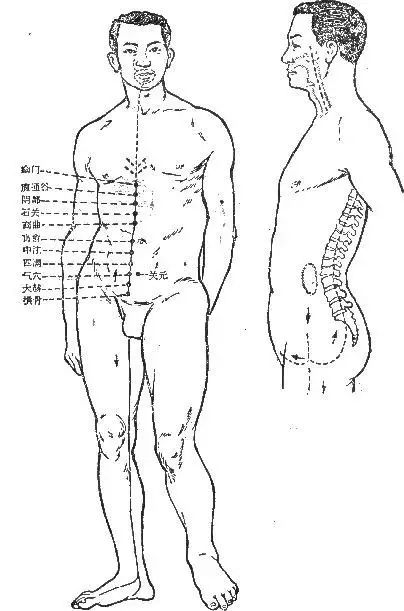
The Nei Jing does not provide a systematic and complete record of the Chong Mai’s pathway, and later physicians’ understandings have also been inconsistent.
Zhou Huan and Feng Hechang have verified that the Chong Mai has five branches:
1. The Chong Mai originates from the womb;
2. The external pathway begins at the “Qi Street”;
3. It is closely related to the Foot Shaoyin (Kidney) and Foot Yangming (Stomach) meridians;
4. The posterior branch ascends along the spine;
5. The anterior branch ascends to the mouth and descends to the big toe and the sole of the foot.
However, there are slight differences in their specific pathways.
The national standardized textbook “Meridian Studies” summarizes five routes:
1. From the lower abdomen, it emerges shallowly at the Qi Chong area, ascending alongside the Foot Shaoyin Kidney meridian, passing beside the navel to the chest and diffusing;
2. After dispersing from the chest, it ascends to the nasal cavity at the “Huang Sang” point;
3. Originating below the kidneys, it emerges at the Qi Chong, following the inner thigh, entering the popliteal fossa, and traveling along the inner side of the tibia to the inner ankle, entering the foot;
4. From the inner side of the tibia, it diagonally enters the inner ankle, reaching the foot tarsus, and following the path to the big toe;
5. It branches from the lower abdomen, penetrating the spine, and travels along the back.
There is inconsistency in whether the Chong Mai in the abdomen follows the “Foot Shaoyin meridian” or the “Foot Yangming meridian”. The statements in the Su Wen and Nan Jing, along with later physicians’ annotations, are not uniform. Teacher Li Ding believes that the Chong Mai originates from the pylorus to the transverse bone, with approximately every inch having a corresponding point, totaling 22 points on both sides, as they all belong to the Foot Shaoyin meridian. Therefore, it is said that the Chong Mai “follows the Foot Shaoyin meridian,” while the Foot Yangming meridian does not intersect with the Chong Mai except at the Qi Chong point.
3. Understanding the Wei Mai and Jiao Mai
◎ Wei Mai
The Nei Jing does not provide specific discussions on the pathways of the Yin Wei Mai and Yang Wei Mai. The Nan Jing states, “The Yang Wei originates at the convergence of all Yang, and the Yin Wei originates at the convergence of all Yin.” Huang Zhuzhai believes that this refers to the Jinmen (Golden Gate) and Zhubin points, thus confirming them as the starting points of the Yin Wei Mai and Yang Wei Mai. Many later writings (such as the Nan Jing Jiao Shi, Nan Jing Shi Yi, and Nei Nan Xuan Shi) advocate this view. Others believe it refers to the Xuan Zhong and San Yin Jiao points.
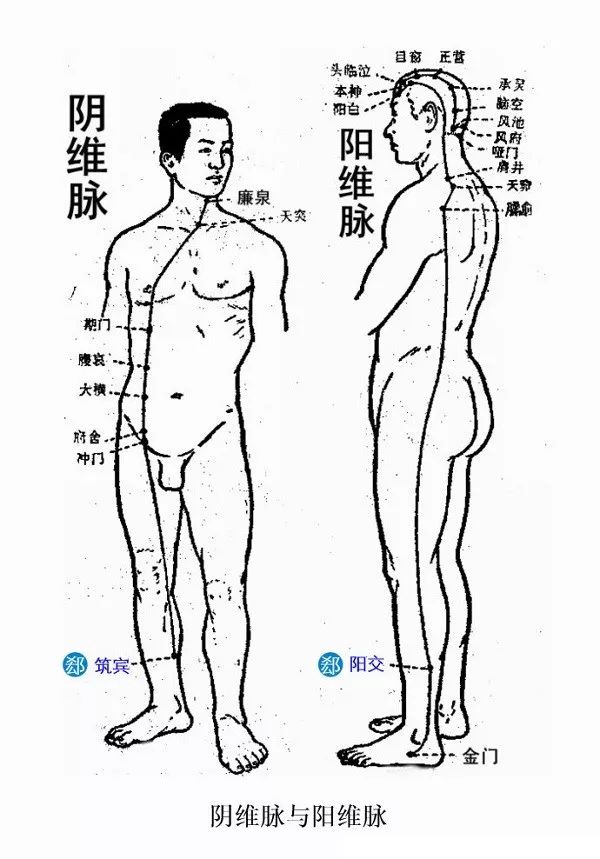
Teacher Li Ding interprets the Wei Mai based on the explanations from the Yuan Dynasty’s Hua Shou in “The Expansion of the Fourteen Meridians,” understanding that the Wei Mai connects the various meridians like a network, playing a role in storing and regulating Qi and blood. Its distribution does not have an upper and lower circulating relationship. The “convergence of all Yang” does not refer to the Jinmen point but rather to the meeting points in the head and shoulders; similarly, the “convergence of all Yin” does not refer to the San Yin Jiao but rather to the meeting points in the abdomen.
The Yang Wei Mai connects all Yang meridians to the Du Mai, intersecting at the Fengfu (Wind Mansion) and Yamen (Mute Gate) points; the Yin Wei Mai connects all Yin meridians to the Ren Mai, intersecting at the Tiantu (Heavenly Prominence) and Lianquan (Lian Spring) points. The Wei Mai does not circulate like the fourteen meridians but rather connects the various meridians, gathering their Qi and blood into the Ren and Du, thus linking the meridians and regulating the abundance and deficiency of Qi and blood. This is further supported by systematic corrections of the meeting points of the Wei Mai in various historical medical texts such as the Jia Yi Jing, Wai Tai, and the Study of the Eight Extraordinary Meridians.
◎ Jiao Mai
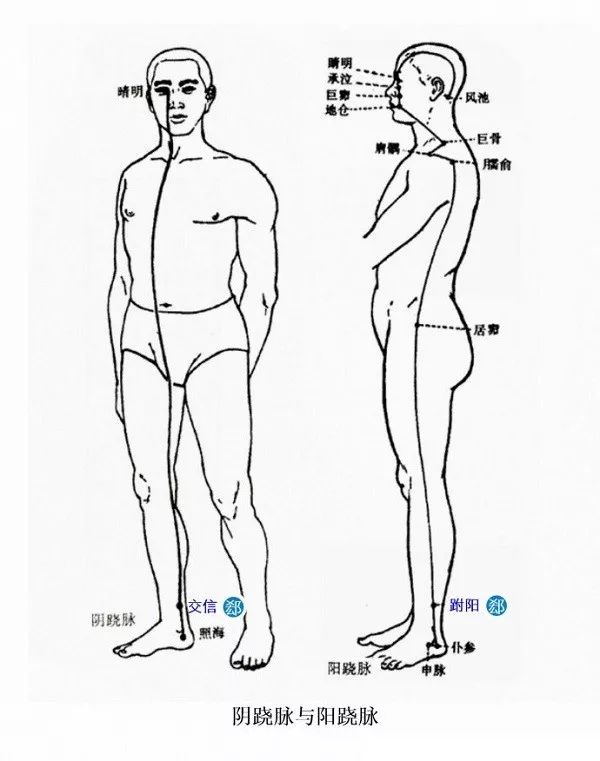
According to the Nan Jing, “The Yin Jiao Mai also originates from the center of the heel, ascending along the inner ankle to the throat, intersecting with the Chong Mai.” Teacher Li Ding believes that the Yin Jiao Mai should cross left and right in the neck (before the Renying point) and ascend to the side of the opposite nose, intersecting with the Yang Jiao Mai at the inner canthus of the eye and connecting to the brain. Previous meridian diagrams did not depict the part where the Yin Jiao Mai “intersects with the Chong Mai.” Teacher Li Ding corrected this and added the segment “ascending from the neck to the side of the opposite nose.” He also studied the flow of Wei Qi and the original meaning in the Nei Jing, concluding that the Yin and Yang Jiao Mai intersect at the eye, with the Yang Jiao Mai flowing from the eye to the foot and the Yin Jiao Mai flowing from the foot to the eye, aligning with the principle of “Yin ascending and Yang descending.”
4. Understanding the Pathologies of the Extraordinary Meridians
Research on the pathologies of the Extraordinary Meridians generally considers them to be unique conditions. Gao Xiyan and others, through studying the treatment rules of the meeting points of the Yin Wei Mai and Yang Wei Mai, and comparing them with the pathologies of the twelve primary meridians, believe that the pathologies of the Extraordinary Meridians are a summary of the pathologies of the twelve primary meridians from different levels and angles, rather than being special conditions independent of the twelve meridians.
“Yang Wei causes suffering from cold and heat” summarizes common symptoms such as fever, headache, and sweating (or lack of sweating) associated with the three Yang meridians. “Yin Wei causes suffering from heart pain” summarizes conditions related to the Foot Three Yin meridians, including various diseases of the stomach, chest, abdomen, heart, lungs, gastrointestinal tract, urinary, and reproductive systems. “Yin Jiao causes Yang slackness and Yin urgency” is a general term for various conditions in the chest, abdomen, and inner thighs. “Yang Jiao causes Yin slackness and Yang urgency” primarily refers to conditions in the head, face, neck, shoulders, back, waist, and outer thighs. The pathologies of the Jiao Mai focus on conditions in the inner and outer thighs under the circumstance of Yin-Yang imbalance. The Dai Mai pathologies concentrate on diseases of the waist and abdomen, while the Du Mai pathologies emphasize conditions in the brain and back. The Ren Mai and Chong Mai pathologies focus on reproductive system diseases.
5. Understanding the Relationship Between the Extraordinary Meridians and the Zang-Fu Organs
Qian Zhiyun believes that the Eight Extraordinary Meridians have a relationship of Yin-Yang and exterior-interior correspondence, but does not specify the relationship of the Chong and Dai Mai in this regard. The text only discusses the close relationship of these eight meridians with the kidneys, without stating which Zang or Fu each meridian belongs to. Qin Lixin, through analyzing the characteristics of the pathways of the Extraordinary Meridians, believes that the Zang and Fu associated with the Extraordinary Meridians are the kidneys, brain, gallbladder, and womb. He proposes that the Extraordinary Meridians are “independent of the twelve meridians, forming a unique system that corresponds to the kidneys as the ‘Zang’ and the extraordinary Fu organs, governing growth, development, and reproduction.” Teacher Li Ding discusses the view proposed by Qing Dynasty scholars Wu Jutong and Ye Tianshi that “the Eight Meridians are subordinate to the liver and kidneys” based on the connections of the meridians.
6. Issues to be Resolved
Since the 1980s, significant achievements have been made in the theoretical research of the Eight Extraordinary Meridians, primarily in supplementing and refining the pathways of the Du Mai and Chong Mai, as well as the meeting points of the Jiao and Wei Mai. New understandings of the flow directions of the Du Mai, Yang Jiao Mai, and Wei Mai have emerged, negating the previous belief that the Extraordinary Meridians all flow “from bottom to top.”
Future research should focus on the following aspects:
1. Further in-depth research on relevant theories from a literature perspective;
2. Combining the theories of the Extraordinary Meridians with modern scientific techniques for validation;
3. Research on the Extraordinary Meridians should integrate acupoints and meeting points, and be combined with clinical applications.
Source: Chinese Journal of Medicine, 2002, Vol. 17, Issue 2, Authors: Gao Xiyan, Cheng Yan’an, Xu Jiangyan, reprinted from the “Elephant Medical Friends Association” WeChat public account/Edited by: Weijian
» If you find this article valuable, please share it with your friends!
|
One article a day, sharing secrets for nourishing the heart, body, and spirit. TCM treasures, there must be one that suits you! |
Click“Read the original text”, discover more exciting content……
↓↓↓

